Nintendo lore but mainly Zelda
Last active 4 hours ago
Don't wanna be here? Send us removal request.
Text
I always liked the anime illustrations in the original NES Zelda manual, and it saddened me to find out these weren’t actually part of a real animated promotion for the game. So I decided to take those illustrations and re-create them as if they were!
Enjoy this long-lost VHS promotion for the Legend of Zelda on the Nintendo Entertainment System!
Voice narration by Streamy McDreamy
Animated in Procreate and Procreate Dreams.
View this video on YouTube here.
9K notes
·
View notes
Text
so cool!!!
The Cars of Mario Kart World
Mario Kart World introduces a brand new open-world style to the Mario Kart series, and with it, an entire island jam-packed with details to explore. While others were focused on completing missions, finding medallions or jamming to the banger soundtrack, another detail caught my attention: The many cars, trucks and other vehicles seen all over the island.
Together with @seandwalsh, we have catalogued every type of vehicle that can be found in this game, and discovered there seems to be a surprising amount of thought over which brands each vehicle belongs to. So here's our breakdown of what the biggest car manufacturers in Mario Kart World are!
Dash
The biggest car brand in Mario Kart World seems to be Dash, represented by a mushroom emblem. What could be their main office can be seen in Crown City, plastered with advertisements and their logo all around. Their slogan is "Accelerate the fun". They appear to sell popular cars for regular use, and are responsible for most cars around the island, including taxis and sheriff cars.
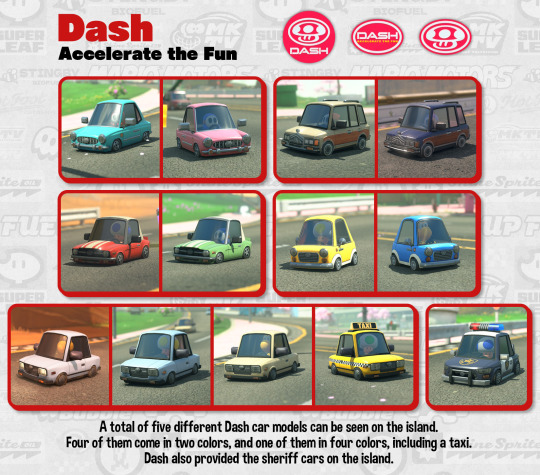
Fire Flower
Fire Flower is another brand of cars for popular use found in Mario Kart World. Their emblem is a square-ish Fire Flower and their slogan, according to a sticker, is "Bloom outdoors". This fits perfectly with the types of cars that carry their emblem, those being outdoors cars such as minivans, RVs and off-road cars. Amazing attention to detail.
Fire Flower also provided the new Mario Kart Television vans.
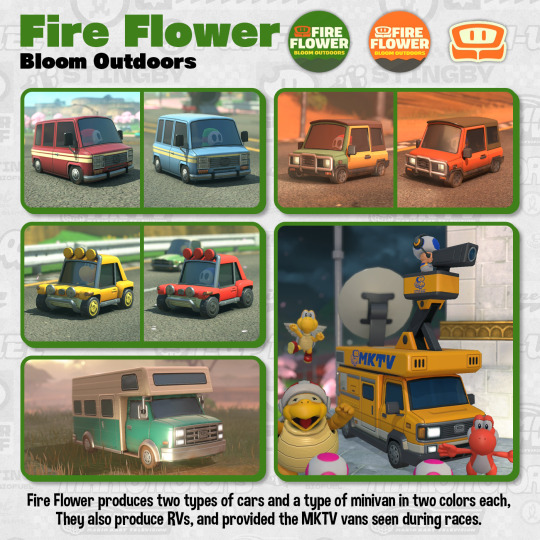
Super Leaf
Leaving the realm of cars, Super Leaf seems to be the main seller of large vehicles, and their emblem is, adequately, a Super Leaf. They are responsible for the cargo trucks, ramp trucks and tour buses that provide service around the island. The large drivable cargo trucks also appear to be modified versions of this company's trucks.
Interestingly, they make the box trucks that run around dropping Dash Mushrooms on the road. These trucks also have Toad Manufacturing branding on them (the company that runs Toad’s Factory), suggesting that they collaborated with them (or maybe modified Super Leaf trucks).
They also have a smaller mini truck model for regular use.

Banana
The Banana brand might only have a single model of trucks found in Mario Kart World, which bears this company's banana emblem on them, but it's clear that thought was still put in this Donkey Kong-owned company. Their trucks are seen carrying barrel cannons and furboard ramps around roads. Fitting, for the Kongs.
As a bonus, I have a small theory about this company. Taking the fact that this is a Kong company and that their trucks are used to carry surfboard ramps around, it makes me think of one specific mechanic Kong with a love of surfing…. Funky has been involved in making barrel cannons before, after all.
Nothing is confirmed, but this is fun headcanon to have.

Spiny
The last brand seen on vehicles around the island is called Spiny, and they are branded with a Spiny Shell emblem. Only one model of truck carries this emblem, a purple pickup truck with orange flames. Given the name, and how their trucks are the only ones that carry enemies, it's possible this company is owned by Bowser or Bowser's Minions.
These trucks have been seen carrying Bomber Bill cannons, Hammer Bros., Spikes and other minions, (and vending machines, apparently). A fun little detail is that, unlike other cars that have Toads, Koopa Troopas and Shy Guys driving them around, Spiny trucks have only Koopa Troopas, the most iconic forces in Bowser's Minions.
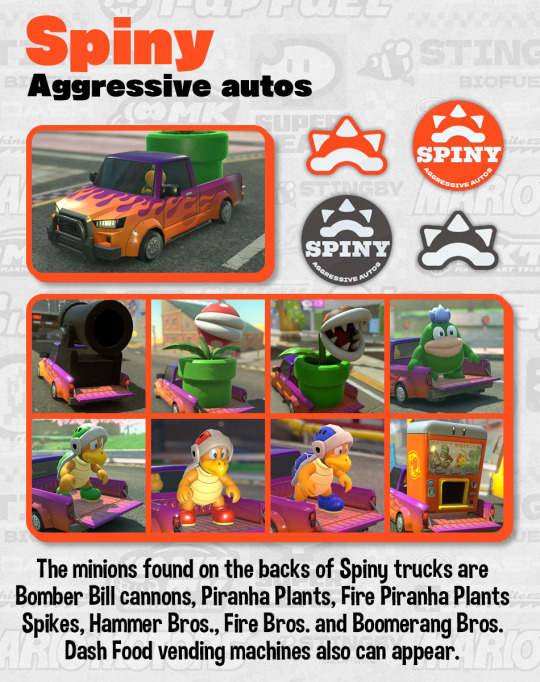
Rosalina Automobile
A Rosalina Automobile (or Automobiles, pick one, Nintendo!) building can be found in Crown City, along with other advertisements and stickers around the island, but no cars seem to bear their star-shaped emblem. For a game with so much attention to detail, it seems odd to have a car brand with no cars. Maybe they haven't opened yet? Or maybe they're actually a rental service?

Other vehicles
Lastly, a few other vehicles don't seem to carry any car brands, making it difficult to guess which company made them.
One of them is a toy-esque car with Toad Manufacturing branding that races around dropping items on the road. Unlike the Mushroom truck, this one has no apparent emblem on it. Since it looks much more cartoony, and resembles the design of Toad's Factory, it is perhaps an entirely original creation by them.
The other three of those vehicles are all the same model of pickup truck, seen carrying around pipes and lifts. They belong to a company called Hammer Bros. Repair Services, but it is unclear who provided the vehicles themselves. The truck's grill and headlights form the shape of a spanner, so perhaps they were customized by this company.
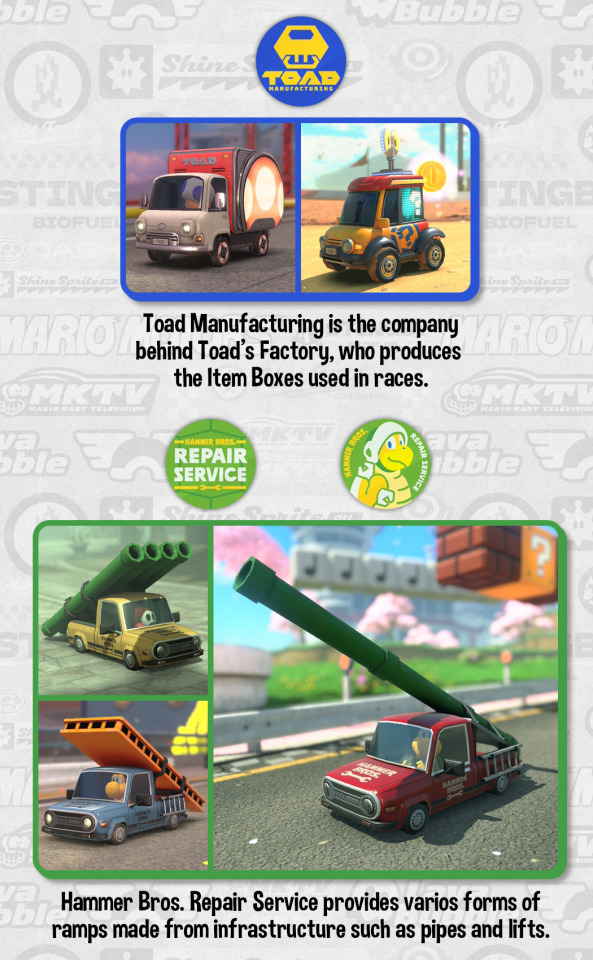
And that's all @seandwalsh and I could gather from the vehicles seen in Mario Kart World!
Thank you for reading through my ramblings, and I hope you can now appreciate this miniscule detail in an already amazing game. If I find anything else about those vehicles, I'll make sure to make a follow up post in the future!
317 notes
·
View notes
Note
Do you have any ideas about what's going on with Pauline in Donkey Kong Bananza? Why is she a child when the game is set in the modern day? Time travel? A redesign just for this game? Completely seperate person with the same name (and singing talent)? It's driving me...bananas....
I wish!
These are all very good questions! However without any meaningful evidence from trailers (only happenstance), I don’t have the answers yet…
However, I’m sure there will be answers when the game releases next month. Aging a character down by 15 years or so, without explanation, is not something Nintendo, let alone Mario or Donkey Kong games have ever done. I am positive that the promotional material is being intentionally vague about why Pauline is so young and what VoidCo wants with her to drum up online discussion and intrigue - and it’s certainly worked on me!
I’ll be first in line at launch to find out exactly what the deal is here.
At the moment, the best hypothesises I’ve seen speculate that VoidCo is responsible, and that her being young was necessary for whatever they’re doing with the Banandium Root at the core of the world. Either she’s been time-displaced or magically de-aged, and this franchise is hardly a stranger to either concept. Let’s wait and see!
16 notes
·
View notes
Text
The Stuffed Bellbloom and the Mystery of Sparklium: A Pikmin Theory
Hey! Pikmin (HP) is considered a black sheep in the Pikmin series, standing out by offering a much different style of gameplay compared to other entries. Because of this, HP is often overlooked and disregarded when compared to the more streamlined, numerical entries. Despite this treatment, the influence of HP on the series cannot be denied, with one of the most prominent examples being the presence of Sparklium in Pikmin 4, an energy source first introduced in HP. Given the clear story relevance that HP has on the rest of the series, it may be worth analyzing other aspects of the game to see if a greater understanding of the wider narrative can be gleaned.
In the second level of Snowfall Field, the seventh sector of the game, Olimar encounters an enemy called a Stuffed Bellbloom.

This enemy appears to be a bulbous yellow sphere, with four tiny legs supporting its massive frame. On the front of its body are what appear to be porous holes, potentially its eyes. It has a large tail on its rear, resembling the opening of a bag, fitting given it releases Sparklium Seeds from this “opening” during the fight. Upon being defeated, it drops the Fond-O-Sphere, recognizable as a marble with a heart in it. While it may be easy to overlook a strange, one-off enemy in a Pikmin game, there may be more to this creature than meets the eye. Its general appearance heavily calls to mind a more common Pikmin enemy, the Yellow Wollyhop.

While these aesthetic similarities alone are rather striking, Young Yellow Wollyhops, the juvenile form of a Yellow Wollyhop, are frequently encountered in this area, with two being located right before the chamber of the Stuffed Bellbloom, suggesting a relationship between these juveniles and the Bellbloom.

Furthermore, it can be demonstrated via gameplay footage that the Yellow Wollyhop and the Stuffed Bellbloom have very similar mannerisms and attacks; they both hop in the air before crashing down on any Pikmin below them, and upon death they turn over on their side, defeated.
Given the aesthetic similarities as well as the direct connection to Young Yellow Wollyhops, it’s a reasonable conclusion that the Stuffed Bellbloom is, somehow, a Yellow Wollyhop. However, that merely opens the door for more questions; how does a Yellow Wollyhop change so drastically to become the alien-like Stuffed Bellbloom we see in HP?
The plot of HP (and to a lesser extent, Pikmin 4) revolves around collecting the previously mentioned Sparklium, or Sparkling Energy (キラキラエネルギー), a strange type of energy that is used as fuel for space-faring vessels, such as the S.S. Dolphin II and the S.S. Shepherd. This strange fuel is acquired in various ways, including by siphoning it from a wide variety of strange items.
Indeed, Sparklium is found in many objects, from household items like a Gameboy Advance to even living things such as plants - seeds full of Sparklium, also called Sparkle Seeds (キラの実), are found in abundance in HP. The Fond-O-Sphere that the Stuffed Bellbloom drops also contains Sparklium energy. Given that Sparklium can affect flora, as demonstrated by Sparklium Seeds, is it also possible that it can affect fauna?
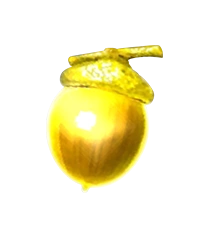
The final boss of HP is the Berserk Leech Hydroe, which was originally just the Leech Hydroe until an important part of Olimar’s Ship, the Sparklium Converter, was lodged in its head. Olimar has this to say about it in the ingame logbook:
Normally, this is a harmless species of plant life. We only found out later that it grew vicious because the Sparklium Converter fell from the ship during our crash landing, falling onto the Leech Hydroe as it slumbered. The influx of energy sent its parasitic urges out of control.
Olimar - Hey! Pikmin
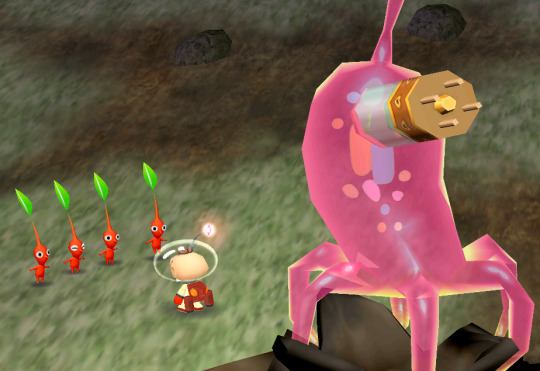

From here, we learn exactly what caused the Leech Hydroe to become violent and change appearance; the influx of energy - that is, the Sparklium from the Converter - modified its biology, sending its “parasitic urges out of control.” Because of this, we can determine that Sparklium can affect non plant-life as well. With this in mind, it is not out of the realm of possibility that the Stuffed Bellbloom is a Yellow Wollyhop that has been “affected” by Sparklium to a degree that its physical makeup has been substantially changed from that of a typical Yellow Wollyhop.
However, that merely opens the door to another question: If Sparklium can affect creatures in this way, what is Sparklium?
The Geiger Counter ship part that can be found in both Pikmin 1 and Pikmin 4 could be particularly revelatory here. As Olimar says,
This noisy gauge is always letting off spontaneous clicks and buzzes. It can be kind of annoying.
Olimar - Pikmin
Naturally, the implication here is that the Geiger Counter is commonly surrounded by radiation. This insinuates that the surface of PNF-404 is irradiated, which suggests a possibility: Sparklium may simply be radiation.
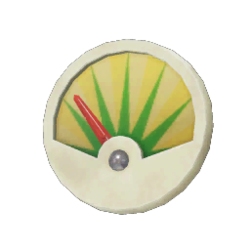
This interpretation of Sparklium is also supported by an in-universe note from Olimar in Pikmin 4, detailing treasure. It is accompanied by the following image:

Interestingly, per Pikipedia, the fan-run Pikmin Wiki, the above image features the following sentences written in the in-universe alphabet first used in Pikmin 3:
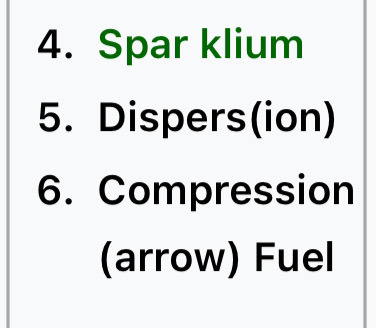
The references to dispersion and compression in this context are interesting; compression refers to the turning of raw Sparklium into fuel - probably by a Sparklium Converter, as seen in Olimar's S.S. Dolphin II in HP. Dispersion, however, could refer to the dispersion of radioactive ions, resulting in objects and creatures being influenced by radiation energy. This seems even more likely with the separation of "ion" from the rest of the term in dispersion.
This would explain several things: why Sparklium can be found within objects as well as living things such as plants and animals, why it can be used as an energy source, and, pertinent to the original purpose of the article, why it had the effect it did on the Stuffed Bellbloom.
A Yellow Wollyhop hoarded items full of Sparklium - or, more blatantly, radiation - which severely irradiated its body and caused its molecular makeup to begin drastically changing from its previous form.
In conclusion, while this isn’t necessarily conclusive on the topic of what Sparklium is, it strongly supports the notion that Sparklium is radiation energy.
13 notes
·
View notes
Text
sick find!
I'm making this its own post because it's getting LONG but I might have found The Place


The trees and slope are close with the acknowledgement that these were in canon taken 100 years apart but wait there's more


This angle is harder to get but you can see there is a hard dirt clearing, and it also forms small, shallow puddles when it rains

Not only that but it's in a very interesting location, extremely close to major locations but is itself fairly remote, and just far enough from the road to be hard to see between the mist and the trees

Which is directly south of

Which just so happens to be the only place in game where we see fog with white motes

AND ALSO has fireflies, just as a bonus


Unfortunately for us/fortunately for nintendo et al the mist and lighting in the cutscene make it extremely difficult to see the surroundings. Any inconsistencies can also be explained away by the intervening 100 years and the fact that it's technically in a different universe and most of the kingdom was destroyed.

What's that wall(?) doing there?


The color's off (lighting?) but that rock looks more like the knobby, cracked Eldin rocks just a little way up the slope than the gray, smooth rock in the rest of Hyrule


Like the gray rock face on the north side of the clearing
At the very least they probably took an in game location and tweaked it as opposed to creating a whole new location from nothing just for one tiny cutscene. And we already know they will plausible deniability the absolute living crap out of any detail about Astor instead of having to gasp confirm any detail about his backstory
49 notes
·
View notes
Text
Where does Astor come from?
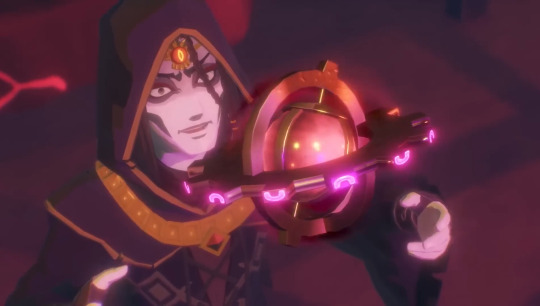
Astor is one of the main antagonists of Hyrule Warriors: Age of Calamity who lived in the era 100 years prior to The Legend of Zelda: Breath of the Wild. He is a follower of Calamity Ganon and works with the Yiga Clan to ensure his revival. He uses Harbinger Ganon, which is the miniature Guardian Terrako who had been corrupted by Ganon's Malice from the future, to see visions of the future.
In Age of Calamity, Astor is given little backstory or context. He is stated in his in-game profile to be from a certain small village in Hyrule and wears robes that are emblazoned with the symbol of the Gerudo, meaning he is likely one of the few in Hyrule who is aware of Calamity Ganon's origins as the Gerudo King Ganondorf, alongside the Gerudo themselves and possibly the Yiga Clan. Furthermore, in the DLC Guardian of Remembrance, it is revealed that Astor was part of a group of people who worshiped Ganon and wore similar robes to him. When they found Harbinger Ganon, all of them were killed except for Astor, which he interpreted as being chosen by Ganon.
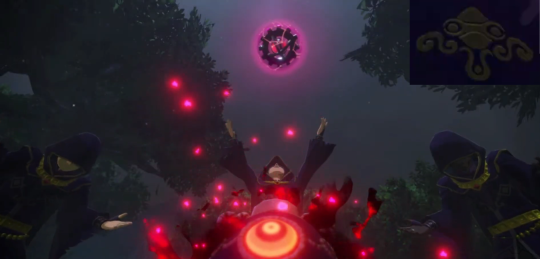
This is more or less all that is given in Age of Calamity. There has been an idea floating around that Astor is also the fortune-teller who informed the royal family of the Sheikah technology buried all around Hyrule that needed to be dug up in order to oppose Calamity Ganon's revival. The idea being that the fortune-teller lured the royal family into a trap, as Ganon would go on to possess the Sheikah's technology and use it to destroy most of the Kingdom of Hyrule.
While Astor can see the future in Age of Calamity, this ability is entirely predicated on Harbinger Ganon. It consequently only exists because Terrako from the main timeline wherein Breath of the Wild takes place traveled to the past to avert the revival of Calamity Ganon. Some of Ganon's Malice followed it and possessed Terrako of the past in the new timeline, after the royal family had already begun to dug up the Sheikah's technology. Astor could thus not have seen the future in the main timeline and by the time he gains the ability to do so in Age of Calamity, that particular prophecy has already been spoken out.
The voice memories included in Zelda Notes with the Nintendo Switch 2 versions of Breath of the Wild and Tears of the Kingdom might reveal where Astor originated from. In memory #95, Den of Madness, Zelda tells that cultists who worship the Demon King once lived in Hyrule. They consider the giant fossil in the Bottomless Swamp an idol worthy of their worship.
"I have heard that the giant fossil in Bottomless Swamp was once worshipped by cultists who considered it the Demon King from ancient times."
This could refer to the group Astor is a part of or the Yiga Clan, who similarly follow Calamity Ganon. Two other memories may identify the village Astor is from, specifically memory #90, The Shadow People, from Breath of the Wild and memory #89, The Lost Hamlet, from Tears of the Kingdom.
"The Shadow Hamlet is a secluded village where people prefer to live somewhat disconnected from the rest of society. Many in Hyrule do not even know this place exists. I at least, knew the name, but I had no idea it would be like this. I came to warn the people here about the Calamity, but they turned me away..." "No one actually knows what happened here at the Shadow Hamlet during the Calamity. They were a very isolated village, and they liked it that way. They even turned me away when I came to warn them about the Calamity. I wonder if this place would be more than ruins if I had tried harder to get them to listen..."

This is about the Shadow Hamlet Ruins, found on the eastern foothills of Death Mountain in the game. It is a secluded place with only a few wooden houses, which apparently housed a reclusive people that did not wish to leave their home when the Calamity threatened Hyrule 100 years ago. It seems plausible that Astor and his fellow Ganon worshipers may have lived here, eagerly awaiting the Calamity, and likely perished during the event in the main timeline. Given that they worshiped Ganon, they likely secluded themselves from the rest of Hyrule, who consider Ganon evil.
109 notes
·
View notes
Text
On the origins of Shez
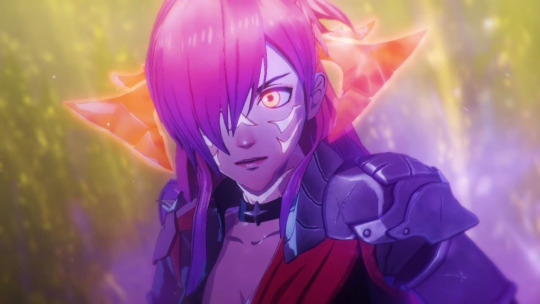
Shez is the protagonist of Fire Emblem Warriors: Three Hopes and a mercenary who helps shape the war that erupts across the continent Fódlan during the events of the game. They are not in the original game, Fire Emblem: Three Houses, likely because their survival in a battle against Byleth marks the point where the timeline of Fódlan diverges to lead either into Three Houses or Three Hopes.
And while they appear to be a simple mercenary at first, their origins are shrouded in some mystery. They share their body with a being known as Arval, who can grant them great power. So what actually are the origins of Shez and Arval?
Shez’s life before becoming a mercenary
Shez is thought to be in their late teens, as they are said to be around the same age as the students attending the Officer’s Academy of Garreg Mach Monastery by Archbishop Rhea. It is unknown who their biological parents are, as they were raised by a woman in a secluded mountain village. The village was situated in the Ordelia territory in the far south of the Leicester Alliance.

(Credit to @cartographers-office for removing the names from the Fódlan map used in the above picture)
In various Support Conversations, more details are given about this time of their life. To Yuri, Shez tells that their adoptive mom took them in when they were abandoned. Most of their Support Conversations with Ashe are dedicated to their mom. It is said she was a smart woman who knew about most things, including magic. She also taught Shez arithmetic, to read and to navigate using maps, things that are noted that only nobles are taught in Fódlan. Finally, to Claude Shez explains that their mom at one point fell ill and died. They were then chased out of their village and they fell in with a mercenary group when they ran out of money. Shez started out by doing their laundry and eventually worked up to become a fighter, which is they are found at the start of Three Hopes.
On Epimenides and Arval

The backstory of Shez raises some questions, but is mostly just vague on its own. However, Shez’s body also houses the being known as Arval. They awaken when Byleth is about to kill Shez and grants them power that allows them to survive the encounter. The presence of Arval, who does not have any memories either, raises many more questions about where Shez originally comes from. Arval’s origins are explained more in Chapter 15 of Three Hopes, The Hour of Vengeance, and the Paralogue Cycles of Nostalgia.
In the former, a man called Epimenides who looks identical to Arval, talks with Arval. He explains that his race wavers at the brink of extinction and that he seeks to reclaim the world for his people. He created Arval and seems to have sought to place his own soul within Arval, but this is a dangerous technique that can lead to irreparable consequences if an essence is wrongly transplanted. The initialization of Arval’s consciousness faced an unforeseen accident, but proved to be useful to Epimenides in another unspecified way, which would allow Arval to become Epimenides.
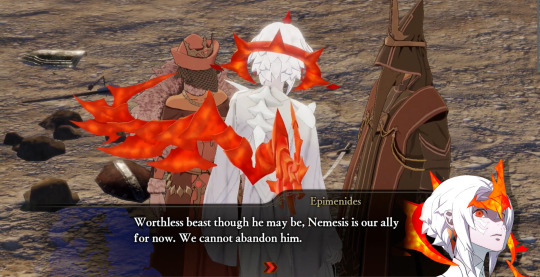
The identity of Epimenides is made more clear in Cycles of Nostalgia and the introductory cutscene of Three Hopes. There, he is seen fighting in the War of Heroes that transpired more than a thousand years before the events of the main games. He fights against the forces of the Adrestian Empire and the Four Saints led by Saint Seiros leading several dark mages in battle, aiding the forces of the Liberation King Nemesis. He also references Thales, the leader of the Agarthans or Those Who Slither in the Dark. This makes it clear that Epimenides is an Agarthan. This is further made clear by the presence of ruins that bring to mind Shambhala, the underground home of the Agarthans, in the void of Zahras where Epimenides and Arval reside.

The introduction cutscene of Three Hopes then shows how Epimenides met his end and how Arval failed to initialize. During a battle of the War of Heroes, Epimenides led some Agarthan mages into battle and caught the attention of Saint Seiros. She transformed into her dragon form, the Immaculate One, and killed the Agarthans, including Epimenides. Before that, water is seen rushing and some markings that indicate this is inside Shambhala. This lines up with how Arval’s initialization is described.
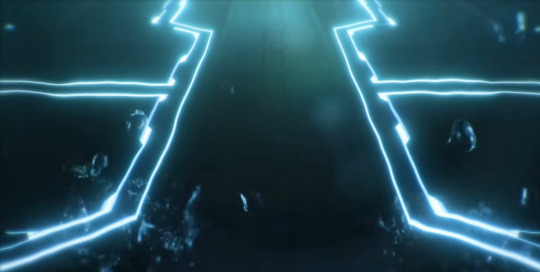
“When my consciousness first initialized, I was nothing. I remember the sound of water… Of bubbles… The sound of a massive object slowly lurching along… I thought the noise would continue for eternity. But then…a change. Something gave way. The water began rushing rapidly. Pale shadows closed in around me. Amidst deafening sounds, I walked desperately in search of light.”
What are the Agarthans?
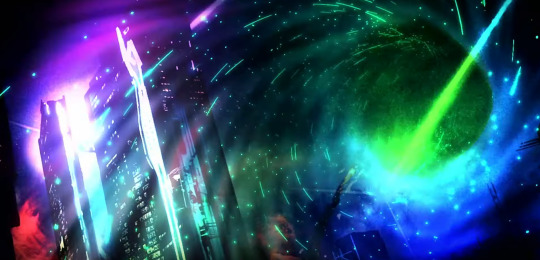
The query as to Shez’s origins and their relation with Arval and Epimenides thus ties into the Agarthans. It also begs the question as to what they are. They appear to be very long-lived, as Thales was around during the War of Heroes and is still the Agarthan leader in the present day. They are also capable of shapeshifting and do not want the secrets of their bodies to be revealed, as Thales says in Chapter 10 of Three Houses.
“If you were to die, then the mystery of our bodies would be revealed. Preventing that was my only aim.” -Thales in Chapter 10 of Three Houses, Where the Goddess Dwells
In Chapter 22 of Three Houses’s Verdant Wind route, Fodlan’s New Dawn, the history of the Agarthans is explained. They were the original humans who inhabited Fódlan and were a technologically advanced civilization. At some point they waged war against Sothis and her children, the draconic Nabateans. In that war, Fódlan was all but destroyed and the Agarthans retreated underground to Shambhala to bide their time. Sothis would eventually use her power to restore Fódlan, although this took an extremely long amount of time.
The Agarthans are thus human and also consider themselves as such. In the Romance of the World’s Perdition, a book found in the Shadow Library in Abyss of Garreg Mach Monastery, they are described as “the children of men”. The book was likely written by the Agarthans and tells of the war against Sothis and the Nabateans from their perspective.
But that begs the question as to how they are so long-lived and have abilities like shapeshifting. A hint might be found in the concept art of the Agarthan Solon, which reveals something interesting about his gloves and eyes.

“He is fitted with a prosthetic eye made with Agarthan technology that can store magical power and knowledge. His right eye does not blink because his eyelids are fixed.”

“These gloves are sewn directly onto the wrist. They have a smooth texture.”
These pieces of concept art, which are reflective of Solon’s final design, reveal that his body is integrated with advanced Agarthan technology. His gloves are sewn directly into his arms and his unblinking eye allows him to store knowledge and magical power. Furthermore, in Chapter 10 of Three Houses, Where the Goddess Dwells, Solon pulls an object from the chest of fellow Agarthan Kronya. He shatters it and uses it as fuel for the Forbidden Spell of Zahras. The object is hard to make out, but appears to be metallic in nature.
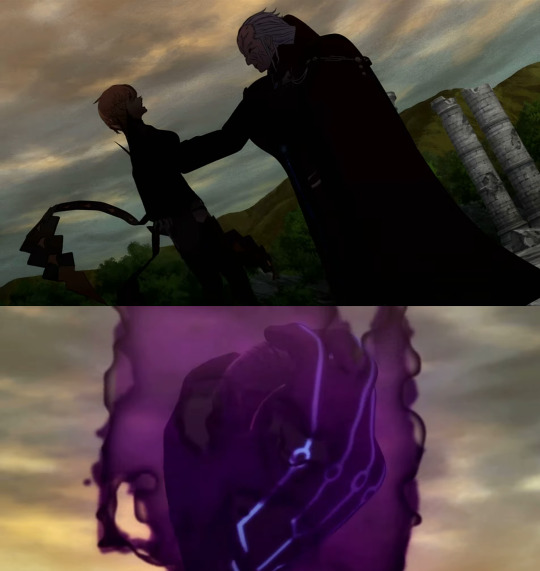
The Agarthans are thus most likely humans who used their advanced technology to cybernetically enhance themselves, giving them long lifespans and the ability to shapeshift. They do not want the humans of Fódlan, who they consider beasts, to discover this and so go to lengths to keep the contents of their bodies a secret. Furthermore, in Three Hopes, it is also implied that they sometimes switch out bodies when their current bodies give out. They talk about “this flesh” when they are wounded and how it has run its course, likely referring to this.
“I need to get this flesh underground…” -Solon in The Hour of Vengeance (Three Hopes) “So this flesh has run its course. No matter.” -Thales in The End of Tragedy (Three Hopes)
Attack of the clones: Arval and Shez
With all of this context, it becomes clear what Shez’s relation to Arval is and what their origins are. Epimenides was likely the one who invented the technique to rehouse souls, allowing the Agarthans to swap out their bodies. Arval was supposed to be a backup body for Epimenides, but things went awry when their consciousness was initialized. Everything was lost according to Epimenides, but then Arval proved useful in a different way.
It seems likely Shez was another backup body of some kind. Solon confirms in The Hour of Vengeance explicitly that Shez is from Shambhala and in Chapter 10 of the route Azure Gleam in Three Hopes, Fanaticism, the Agarthan Myson says the following to Shez.
“Why? Why do you wield the power of Epimenides? […] Tell me, where did you obtain it? Unless… His core!” -Myson in Fanaticism (Three Hopes)
It seems the core is what is transferred from body to body with the Agarthans and may have been the device that Solon pulls out of Kronya in Three Houses. The core of Epimenides was first housed in Arval and came to house their rudimentary consciousness as well after their initialization failed. It was then transferred to Shez, who was created in Shambhala. The streaming water that Arval and Epimenides reference is likely a liquid they were held in while in stasis, perhaps in one of the holding pods on the lower levels of Shambhala that are seen in Three Houses.
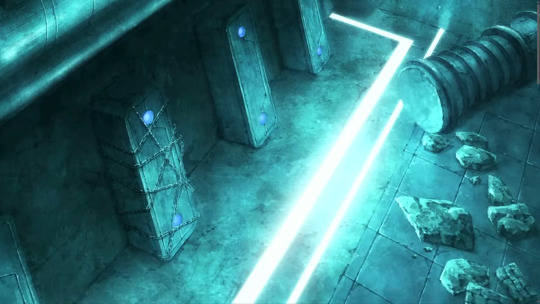
Shez was likely taken from Shambhala by the woman who would become their adoptive mother. She may have been an Agarthan, hence her great knowledge of many fields, who felt pity toward Shez and their destiny to become a vessel for Epimenides. The hamlet where Shez grew up is located not far from Shambhala after all, as its entrance sits on the other side of the Airmid River that borders the territory of Ordelia.

(Credit to @cartographers-office for removing the names from the Fódlan map used in the above picture)
20 notes
·
View notes
Text
The Nature of Twilight Magic and how it affects the World of Twilight Princess
In The Legend of Zelda: Twilight Princess, the Light World is overtaken by an alien magic known as twilight. Twilight magic, or shadow magic (影の魔力), first appears chronologically in the series when a group of magic wielders appeared in Hyrule, entering the ongoing conflict over the kingdom.
人々の中に、魔術に長けた者達が現れ強力な魔力によって聖地を治めようとしたしかし、神は我ら光の精霊を遣わしその者達の巨大なる魔力を 封じこませたのだそして、その魔力こそが黒き力・・・影の結晶石である
Among the people, people who were skilled in magic appeared and tried to rule the holy land with their powerful magical power. However, the Gods sent us spirits of light to seal away their enormous magical power. That Magical power is black power...the Crystal Stone of Shadow.
Lanayru (Twilight Princess) - Translated by Sidier
We learn that these invaders used a powerful magic known as the Fused Shadow, or, per the Japanese release, the Crystal Stone of Shadows (影の結晶石). In this conflict, they almost emerged the victors, until the Goddesses of Hyrule commanded the Light Spirits to put a stop to their plans. As a punishment for their crimes, these magic wielders were sealed away within the Twilight Realm via the Mirror of Twilight, and the Fused Shadow was sealed within three dungeons across Hyrule.

However, this doesn’t tell us what exactly twilight magic, or shadow magic, “is,” or how it affects the Light World. Let’s take a closer look at the information we’re given in the game.
While meeting with the Light Spirit, Faron, he has this to tell us about the Fused Shadow:
この森の奥にある神殿には、黒き力が眠っていますそれは、古代に我ら光の精霊によって封じ込められた禁断の力本来それは、光の世界の者達が決して触れてはならぬもの・・・しかし、影の王よりこの世界を救うにはその力が必要となるでしょう・・・もし、貴方がその力を望むならこの森の奥にある神殿に向かいなさい
In the temple deep in the forest lies a black power, a forbidden power that was sealed away by us spirits of light in ancient times, a power that those of the world of light must never touch... however, you will need it to save this world from the King of Shadows... If you want that power, go to the temple deep in the forest.
Faron (Twilight Princess) - Translated by Sidier
Faron tells us point blank that the Fused Shadow that he and the other Light Spirits sealed away long ago must never be touched by those who reside in the light world. This means little to us now, but his reason for saying this is shown in detail before long. Upon reaching Death Mountain, we learn the plight of the gorons; their patriarch, Darbus, has been corrupted by the Fused Shadow piece that was enshrined deep within the Goron Mines.

精霊様より託されている大事な宝をお護りせねばならねぇからな・・・だが、手に取ろうとダルボスが宝に触れた途端・・・おぞましい異形の姿に化けちまいやがったゴロ!それから奴は見境なく暴れてもうメチャクチャさ・・・噴火も一層 激しくなったゴロ・・・ワシらは必死の力で奴を山の奥深くに封印した
We had to protect the precious treasure entrusted to us by the spirits... But as soon as Darbus touched the treasure to take it in his hand... He transformed into a horrifyingly monstrous shape! Then he went on an uncontrollable rampage... and the eruptions became more and more violent... and we sealed him up deep in the mountain with desperate efforts.
Gor Coron (Twilight Princess) - Translated by Sidier
魔人と化したダルボスを封じるにも、ワシら老いぼれでは限界があるゴロ・・・
There's a limit to what we old men can do to stop Darbus, who has turned into a demon...
Gor Amoto (Twilight Princess) - Translated by Sidier
As soon as Darbus touched the treasure, he was transformed into a demon. This would naturally lead one to assume that the Fused Shadow, as well as all shadow magic, is thus demonic in nature, similar to the magic utilized by the demons in the series such as Ganondorf. However, this isn’t exactly the case.
Later in the game, Zant uses a different Shadow Crystal to turn Link into a wolf in the light world. This magic isn’t just regular shadow magic, such as that used by Midna or the Fused Shadow, but something else. Zelda and Midna both make note of this.
これは、今までの影の魔力とは違う何か別の邪悪なる力・・・
This is some kind of evil power, different from the shadow magic we've seen up until now…
Zelda (Twilight Princess) - Translated by Sidier
アンタにかけられていた魔力の塊さ
確かに、ワタシ達の持つ影の魔力とは違う・・・
It's the mass of magic that was cast on you. It's certainly different from the shadow magic that we have…
Midna (Twilight Princess) - Translated by Sidier
Instead of being regular shadow magic, we learn that it’s actually shadow magic that has been infused with the malevolent powers of Ganondorf, which were given to Zant. Zant then created his own brand of shadow magic using Ganondorf’s demonic powers, and this was the magic he has been using against Link and Midna throughout the game, such as the Shadow Crystal and Black Fog we see at the Palace of Twilight.

この黒い霧は、ザントが魔力で作り出した光を吸い取る影の結晶・・・精霊の光を奪い、ハイラルをトワイライトに変えていた張本人なんだ
This black mist is a shadowy crystal that Zant created with his magic power to suck out the light… he is the one who was stealing the light of the spirits and turning Hyrule into Twilight.
Midna (Twilight Princess) - Translated by Sidier
A running theme that may be apparent by now is that shadow magic commonly appears in the form of crystals - while not necessarily pertinent to explaining exactly how shadow magic works, it is an interesting detail nonetheless. This also heavily suggests that the Shadow Insects that stole the light from the Light Spirits of Hyrule were made of Zant’s shadow crystals - after all, they were designed to absorb light.
Regardless, we can see from the above text regarding Zant’s own brand of shadow magic that it’s altogether reductive to consider shadow magic synonymous with demonic magic. And of course this would be the case, given that the Sols - the “suns” of the Twilight Realm - restore the land back to its original form, before Zant corrupted it, and began turning its population into Shadow Beasts.

ここの皆、まだ完全に影の魔物になった訳じゃない
ザントを見つけ出して、仲間を元に戻してやりたいんだ・・・
ソルは この世界を照らす太陽みたいなものなんだ
それが失われたから、みんな あんな姿に・・・
Everyone here hasn't completely turned into a shadow monster yet. I want to find Zant and restore my friends… Sol is like the sun that illuminates this world. Because that was lost, everyone turned into those shapes…
Midna (Twilight Princess) - Translated by Sidier
While it’s useful to know that shadow magic isn’t inherently the same as demon magic, why does it have a corruptive effect on those who reside in the world of light, then? Zant, speaking for Ganondorf, and later Midna, potentially gives us a clue as to why:
そして、我が神の望みは一つ
光と影を一つの闇に!!
And my God wants one thing. Turn both light and shadow into a single darkness!
Zant (Twilight Princess) - Translated by Sidier
所詮、光と影は交わっちゃいけないんだ
After all, light and shadow must not mingle.
Midna (Twilight Princess) - Translated by Sidier
While shadow magic isn’t evil, it isn’t “good” either. When characters like Darbus or Yeta come into contact with shadow magic, it corrupts them into demons. While it’s not darkness in the same sense as Ganondorf’s magic, it affects the light world in an adverse way that it - effectively - creates a unique type of darkness born from the mixing of light and shadow. The light world’s light also has an adverse effect on the denizens of the Twilight Realm, as demonstrated by Lanayru’s light magic nearly killing Midna, who is only saved by Zelda’s grace.

光と影は、表裏一体・・・どちらが欠けても
成り立ちはしないもの・・・
Light and shadow are two sides of the same coin.
Neither can exist without the other.
Zelda (Twilight Princess) - Translated by Sidier
As Zelda says, the light world and the Twilight Realm rely on each other to exist. However, the blending of the two - the interaction of shadow magic with those who reside in the light - results in catastrophe, and transforms those who are affected by it into demons.
In summary, shadow magic, the magic utilized by the magic wielders who sought to dominate Hyrule, which was passed down to their descendants, the Twili, is not innately demonic, and even has its own equivalent of “light” in the form of the Sols. That being said, it is still innately corruptive to those who reside in the light and turns them into demons and causes demons to gather, effectively creating its own, unique kind of “darkness” in the process.
All that being said, how do these transformations manifest throughout the game? We know characters like Darbus and Yeta were corrupted by shadow magic, but what about, say, other bosses in Twilight Princess? Is it possible they’re also just demonic transformations born from the interaction between the light world and shadow magic? Interestingly, every regular dungeon boss in the game except Stallord features the same term in its title; “Twilit,” or, in the Japanese release, Awoken (覚醒). The fact Stallord doesn’t have this title separates it from these other bosses; this makes sense, given that Stallord is not a creature in possession of the Fused Shadow or a Mirror Shard, unlike the other bosses. Given this connection in the titles of the bosses, it’s likely that the bosses are all intended to have a shared trait or aspect unifying them. Similar to Darbus and Yeta, it’s likely that this unifying trait is that they were creatures of the Light World who were transfigured by shadow magic.
The first boss we face in the game is Diababa. This creature is a massive three-headed plant, clearly resembling a Deku Baba. Given that the Forest Temple is also home to countless Deku Babas and Baba Serpents, it’s incredibly likely that Diababa is a Deku Baba that came into contact with the Fused Shadow piece that was left in the Forest Temple. If we want to be pedantic, it’s possible it’s a Baba Serpent; however, the lack of the forked tongue and the more traditional head shape of the other two heads suggests that it’s probably just a regular Deku Baba.

The third boss we face, Morpheel, is another interesting case of what appears to be a light world being further corrupted by the Fused Shadow. At first glance, it seems completely alien in appearance, with no close resemblance to any creature seen thus far in the game, demon or otherwise. However, a comparison reveals that its “face” is remarkably similar to that of a Bombfish, a fish that is commonly found throughout Lakebed Temple. To further this comparison, it even spits out Bombfish, suggesting that they’re its progeny. Given these facts, it’s likely that Morpheel is a heavily transformed Bombfish that came into contact with the Fused Shadow.

The fifth boss we encounter, Blizzeta, is the corrupted form of Yeta. While it’s never explicitly stated that the Mirror of Twilight is made of shadow magic ala the Fused Shadow, the sages do give us this warning:
だが、心するがよい
かけらには魔力が宿っていることを・・・
But be warned, there is magic in the pieces.
Sages (Twilight Princess) - Translated by Sidier
Furthermore, we already observe the mirror corrupt Yeta into Blizzeta, which Midna notes is due to the mirror’s power, and Yeta even reveals that the mirror has resulted in her falling ill and draws demons to it, similar to the Fused Shadow.

でも、あの鏡が家に来てから病気になったり、魔物が現れたり悪いことばかり・・・
But since that mirror came to my house, I got sick, demons appeared… Bad things happen...
Yeta (Twilight Princess) - Translated by Sidier
あんな大人しかったのに・・・これも陰りの鏡の魔力なんだな・・・
She was so quiet… I guess that’s the magic of the Mirror of Shadows…
Midna (Twilight Princess) - Translated by Sidier
With this knowledge, we can then reasonably deduce that the next two bosses that are in possession of Mirror Shards have also been corrupted, similar to Yeta.
The next boss is in the Temple of Time, Armogohma. Given its unique appearance even amongst other Gohmas, it’s likely that it was a regular Gohma that came into contact with a Mirror Shard and was corrupted. Notably, while its “true form” is that of a smaller spider, its namesake armor appears organic in nature; it has urticating hairs on its abdomen, a spinneret, pedipalps, and can even lay eggs. Given the laser ability and its strong resemblance to the lasers utilized by other Beamos, it’s possible that the Mirror Shard turned a Gohma into some hybrid between a Gohma and the other technology found lying around the Temple of Time.

Finally, the fourth Mirror Shard is found within the claws of the Twilit Dragon, Argorok. If the name wasn’t explicit enough that it has ties to Kargoroks, the vulture-like bird enemies found throughout Twilight Princess, they are also an incredibly common enemy to find flying through the City in the Sky. Because of these facts, it’s very likely that the dragon was just an ordinary Kargorok that stumbled onto a Mirror Shard and was corrupted into a fire breathing monstrosity.

In sum, here is what the transformations caused by the Fused Shadow and Mirror Shards look like:

These transformations exemplify why the Light Spirits are adamant that those who dwell in the light are not to come in contact with shadow magic; it has a corruptive impact, that, even for demons, can turn them into monstrous beasts that make their previous forms pale in comparison. While the departure of Midna and the breaking of the Mirror of Twilight was certainly a bittersweet ending, it was for the best; light and shadow are two sides of the same coin, but it’s for the best that they don’t mingle.
#nintendo#nintendo lore#zelda#zelda lore#the legend of zelda#tloz#loz theory#zelda theory#zelda timeline#loz timeline#twilight princess#loz tp#midna#midna twilight princess#loz midna#zant twilight princess#zant#ganondorf
44 notes
·
View notes
Note
I was wondering, do you know how The Hero of Time got "defeated" in the Downfall timeline? is the timeline a what if, or something else?
Hello! In the Hyrule Historia and Hyrule Encyclopedia, as well as the Zelda Portal website, we're informed that Link was defeated in the final battle with Ganondorf. Per the written text, the following is stated:
At last; Ganondorf found himself in the possession of the Triforce of Wisdom that dwelt within Princess Zelda; and the Triforce of Courage that dwelt in Link. His true power achieved; he transformed into the Demon King. The Seven Sages of Hyrule; led by Princess Zelda; sealed Ganon and the Triforce in the Sacred Realm as a final resort. - Hyrule Historia, pg. 92
Sealing Ganon: The hero fails. Ganondorf steals the Triforces of Wisdom and Courage and transforms into the Dark Beast Ganon. The Seven Sages, including Princess Zelda, seal the unified Triforce and Ganon in the Sacred Realm. - Hyrule Encyclopedia, pg. 11
A story that continues when the Hero of Time is defeated in battle by Ganondorf. - The Legend of Zelda Portal, describing the Downfall Timeline
This suggests that Link was defeated in the first battle with Ganondorf, not the subsequent battle with the demon beast form Ganon took after his castle collapsed. This is further reinforced by the artwork used in the Historia when describing this section being of Link battling Ganondorf.
As far as the Downfall Timeline being a what if, it's treated as a simple split in the timeline stemming from the final battle between Link and Ganondorf.
The life of the time-traveling hero caused the chain of history to branch off in multiple directions. From this point onward, the chronology of Hyrule diverges dramatically. - Hyrule Historia, pg. 91
Now, a few issues immediately pop out: Obviously, the Hero of Time didn't fall during the events of Ocarina of Time. Furthermore, the backstory for Ganon as described in A Link to the Past and A Link Between Worlds differ greatly from what is described in these other materials. While these extra materials suggest Ganon acquired the rest of the Triforce pieces after defeating Link in combat, in A Link to the Past's backstory, it's established that he had acquired the Triforce after stumbling upon the entrance to the Sacred Realm, and defeating his following of thieves in combat for the relic. For what reason did Hyrule Historia attempt to make these changes to the established canon?
Eiji Aonuma described in 2013 that those who wrote the Hyrule Historia were "fans" of the series, and the implication from here, along with the lack of substantial Zelda Team credits in the book, is that it was effectively a select group of fans' attempts at cobbling together their own timeline theory.
When we were exploring ways to make fans happy, we created the Hyrule Historia. That summarizes all the games and the story so far. I didn't edit it myself, but tons of people who worked on it were fans of the games themselves. - Eiji Aonuma, 2013
So, if you think the Downfall Timeline is confusing and doesn't make too much sense, this is probably the reason why! That being said, if it's something you enjoy within the series, by all means, make it work in your interpretation of the series.
In summary: The Downfall Timeline isn't treated as a what if by the books or the recent websites, and was spurred into action by Link's defeat at the hands of Ganondorf in their first battle. It was conceived by "fans" of the series per Aonuma in an attempt to fit the chronology of the series together.
EDIT: A colleague of mine has brought to my attention the confusion that may come with the term “what if.” When I describe the Downfall Timeline as not being a “what if,” I’m applying the term as utilized in media such as Marvel’s What If…? and Star Wars Infinities, where these alternate scenarios are treated as distinct but similar universes in a wider multiverse. I don’t believe the intention of Hyrule Historia was to treat the timeline as a multiverse, but instead a single, unified timeline that branched at the conclusion of Ocarina of Time. If you’re asking if the Downfall Timeline is merely an alternate ending to Ocarina of Time, and interpreting that as a “what if,” then yes, I believe the answer to your question would be that it is a what if.
#zelda#zelda lore#nintendo lore#downfall timeline#hero of time#loz#loz theory#ocarina of time#hyrule historia#hyrule encyclopedia#zelda portal#a link to the past#alttp#oot#zelda timeline
4 notes
·
View notes
Text
Aquatic Pokémon Habitats

This chart shows all water-type, semi-aquatic, and/or aquatic Pokémon, divided by whether they live/hunt in freshwater environments, marine environments, or both! I've taken into account every source from a mainline game I could find. Sources are here (except for the non-Aquatic waters, as that kind of thing is hard to source).
Evolutions are included in their base form's icon! (Except for Armaldo) I used the lowest Water-type member of a line to represent each, or the lowest member in general if none were Water.
I also discounted a few locations across the series: Unova Route 1 (is the ocean and yet has a pool consisting of entirely freshwater species), the river in Sinnoh from the Valley Windworks through Fuego Ironworks (which is a river and yet has marine encounters-- might be something else going on there), Safari Zones that aren't the Great Marsh, the Grand Underground, the Crown Tundra's wild fossils (all of those three have unnatural supply), and the Wild Area (which puts gameplay over ecology).
This was super fun to do! This is an updated version of a chart on my old account, with a better layout and some actual visible sources this time.
(edited to fix an issue with the placement of the Stunfisks and to update saltwater to marine)
(yes i know P-Wooper is in mud flats which are marine. in Pokemon they aren't always)
16 notes
·
View notes
Text
Orsan's Metroid timeline
Reposting this from my old account, with updates to reflect Metroid Prime 4: Beyond news.
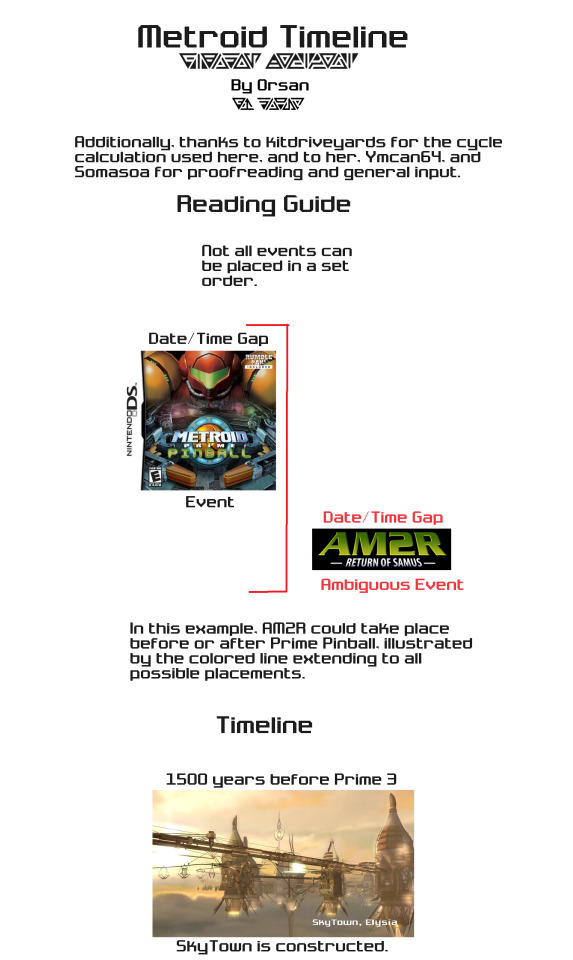





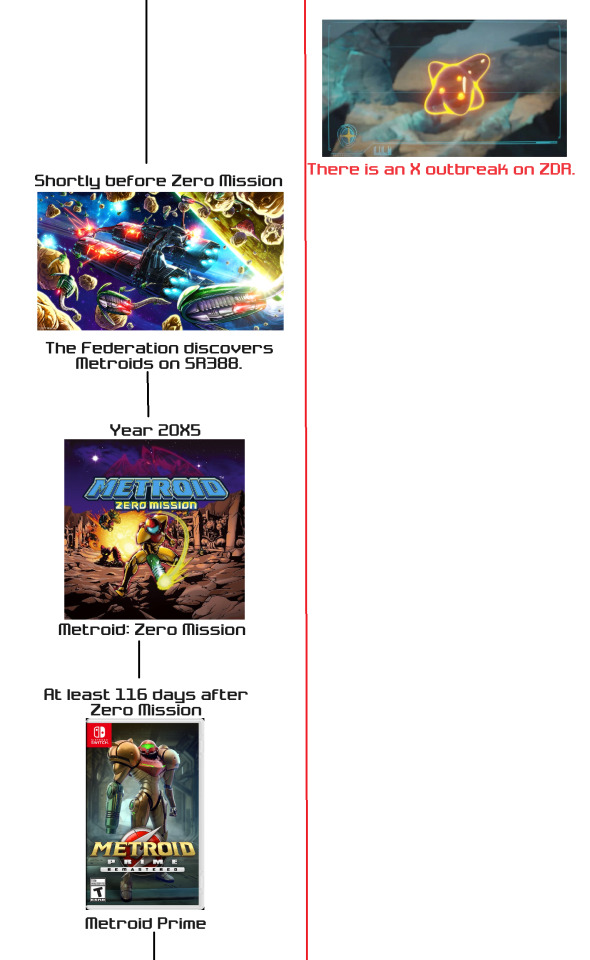



I've aimed to make as few assumptions as possible. Everything here should be reflective of canon information in as much detail as we know. (Although, admittedly, perhaps too many significant figures on the gaps between ZM/Prime 1/Prime 2 and Prime 3/Fed Force.) (If you want to know what order I think events go in, just read top-to-bottom, ignoring the ambiguity lines)
If you have any questions, critiques, or just want to talk, I'm always open to asks or comments asking me about any of my posts! I'm trying to post more lore stuff these days to have publicly available sources for various compilations and deep dives I've done.
Some sources:
Cycle calculation. I used this in conjunction with the logs from Primes 1 and 2 talking about the fall of Zebes to calculate the time gaps between those two games and ZM.
Zebes being settled only after SR388 was massacred comes from this interview with Sakamoto.
Samus's age at various points comes from Other M concept art for both Samus as a child and in the army, in addition to the same interview linked above.
Thanks so much for reading!
20 notes
·
View notes
Text
Exploring the Zelda Merchandise Map

The above is something I have been curious about for a while: a map of Hyrule that is included with many pieces of merchandise. Despite this, this map of Hyrule does not correspond to any game and many oddities can be observed if it is examined in closer detail, which is what I want to do here.
To start with, it appears this map appeared about a decade ago as a licensed puzzle. Since then it has cropped up in all kinds of places, such as the background of the Japanese Zelda Portal, page 14 of The Legend of Zelda Encyclopedia or even just on packaging for stuff like keychains.

But what does the map actually depict if not something from the games? For clarification, it is first handy to look at the Hylian text on the map and translate it. This was already done in the Reddit post linked above and I have my own version of this below.
Of note is that there are various Hylian ciphers throughout the Zelda series. The one used on this map is the one introduced in A Link Between Worlds, which came out around the time the map was made in 2013. This Hylian cipher has gone on to become the standard cipher used in the series, making an appearance in every new Zelda title released since A Link Between Worlds.

This text makes somewhat clearer what landmarks we are actually looking at. It also becomes fairly clear that the middle of the map is based on Ocarina of Time's incarnation of Hyrule: Hyrule Castle sits north of Hyrule Field, with Lon Lon Ranch in the middle. Kakariko Village is east of Hyrule Castle and sits at the foot of Death Mountain, both of them sporting their designs from Ocarina of Time. To the southeast of the field is Kokiri Forest, complete with the Great Deku Tree and Link. Finally, we also have a lake that appears to be Lake Hylia from Ocarina of Time to the sourthwest of Hyrule Field.
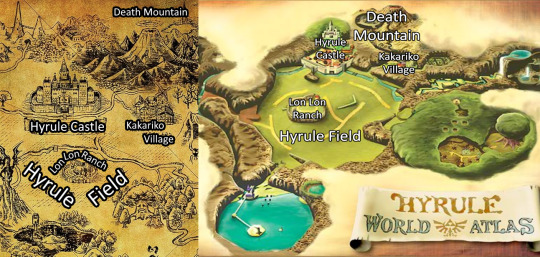

Moving further out, things get a tad stranger however. Let's start in the southwest and move around the map clockwise from there. In that corner of the map, a rendition of Gerudo Desert can be found.
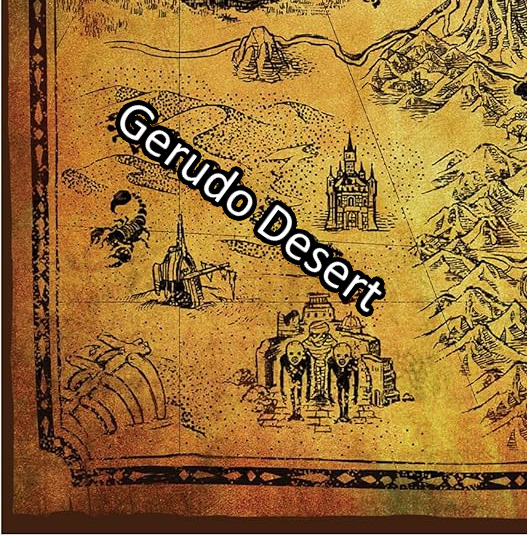
This is consistent with the placement of the desert in top-down Zelda games that were out at the time like A Link to the Past, Four Swords Adventures and A Link Between Worlds. In the 3D games out at the time, the desert instead extended across the entire western portion of the map (Skyward Sword) or the northwest (Ocarina of Time, Twilight Princess).
As for the landmarks on this portion of the map, they are a strange mix. The broken down ship mast may be a reference to the Sandship from Skyward Sword, which was broken after that dungeon is finished. The structure to the bottom of the map appears to be a reference to the Ancient Castle of Ikana from Majora's Mask, given the similarity and the presence of Redeads and a Gibdo (enemies that can be found in and near the castle). This is strange given that the Castle of Ikana is not located in Hyrule, but in Termina, which is a parallel world. The third structure on the top right appears to be an original of the map, but vaguely resembles Hyrule Castle from Twilight Princess.

Moving to the northwest, we find Castor Wilds, a swampy area from The Minish Cap that was also located in Hyrule's west. Interesting to note is that Castor Wild is only the region's name in the English version of The Minish Cap. In Japanese, it is called タバンタ秘境 (Tabantha Wilderness), a name that would be reused in Breath of the Wild and Tears of the Kingdom. This may indicate this map was put together in the west instead of Japan or that the original artist took from the localized games for some reason.
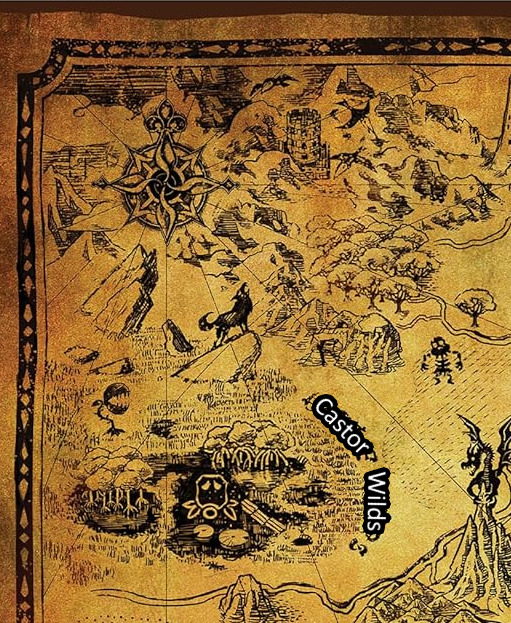
The depiction of Castor Wilds above has more in common with the appearance of the Southern Swamp from Majora's Mask, given the presence of bayou trees, a Deku Scrub and disconnected bridges made of logs. This poses the same problems as the seeming Ikana Castle in Gerudo Desert, as the Southern Swamp is in a parallel world.

There is also a mountain with a dragon on top in this area, east of Castor Wilds. It brings to mind Dragon Roost Island from The Wind Waker, a tall mountaintop upon which rests the dragon Valoo. That place is found in the northeast of Hyrule however and not the northwest. The dragon on the map also does not particularly look like Valoo, nor does the mountain particularly resemble Dragon Roost Island.
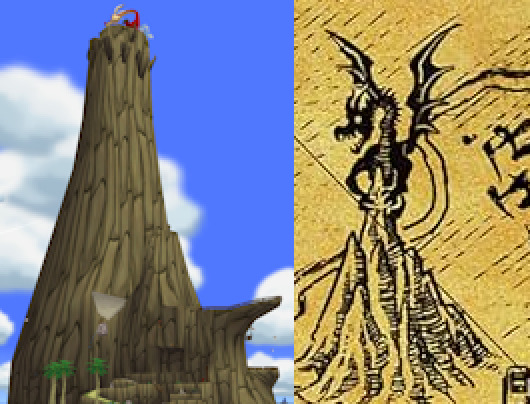
Other than this, there are few notable things in this quadrant. Depictions of a Wolfos, a Deku Baba and Stalchild can be seen, but most of the actual landscape is barren mountains or obscured by the compass. Perhaps the region is supposed to represent Snowpeak, a snowy mountain range in the northwest of Hyrule in Twilight Princess. There appears to be a tower in these mountains surrounded by Guays, but this does not correspond to any known location in the games.
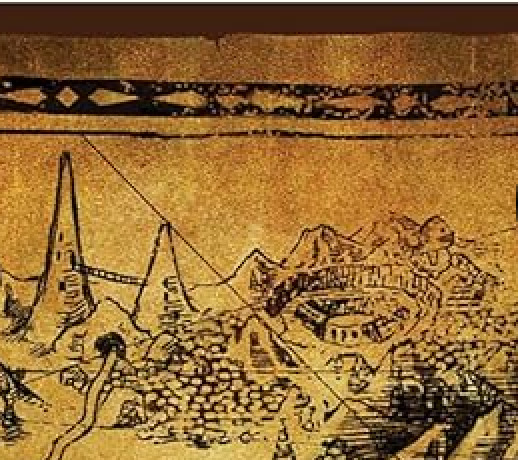
In the direct north of the map are two more structures not in the games: two pointy mountains connected by a rope bridge and a spiral quarry of some kind. A Goron can be seen at this quarry.
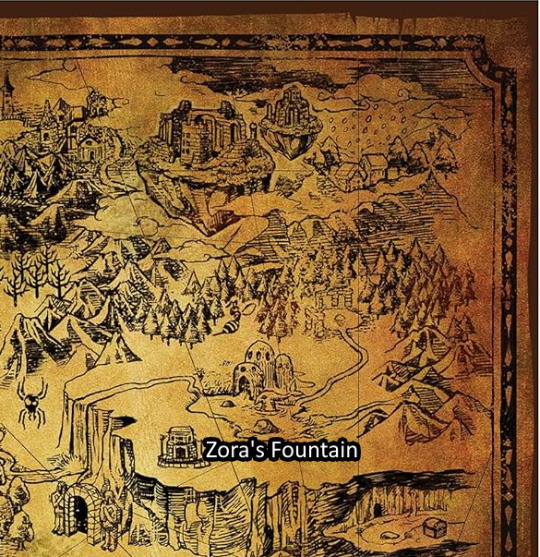
The northwestern quadrant is home to Zora's Fountain, corresponding roughly with its location in Ocarina of Time (south of Death Mountain and Kakariko Village and north of Kokiri Forest). It is far more to the west however, but it is still on top of a mountainous plateau behind a waterfall like in Ocarina of Time. The design of the fountain does not match any depiction found in the games however, albei a Zora can be seen bathing inside it.
Other than this, this quadrant of the map is home to many more structures where it is hard to pin down what they are. There is a village northwest of death mountain, a snowy village in the far northwest of the map and a pond surrounded by ruins that feeds into Zora's Founain. This last structure also somewhat resembles the Fairy Fountains from Ocarina of Time, except that those are found underground. There are also a couple of floating islands, but once again they do not correspond to anything in particular like the City in the Sky or Skyloft.

More to the south of this quadrant we also find a small stone building, a gate guarded by two statues with crossed legs and a cave with a treasure chest. This last structure is likely a reference to grottos from throughout the series wherein treasures can often be found. Finally, a Skulltula is depicted in this quadrant of the map.

The final quadrant of the map, the southeast, is mostly made up of featureless ocean. There is a nondescript ship in that ocean, also what appears to be Gyorg, a boss from Majora's Mask. Other enemies we can find on land here are a Chuchu as first depicted in The Wind Waker and a Peahat. A Gossip Stone is also present in the northeast of the image.
The final names location on the map is Faron Woods, and the art seems to pull from Skyward Sword and Twilight Princess. There is the Great Tree from Skyward Sword's version of Faron Woods and buildings that resemlbe Ordon Village, which is found in the forests south of Faron in Twilight Princess. The general location of Faron Woods on this map also matches that of Ordon, being found in the far south of Hyrule, beyond lake Hylia and many of the woods.

Finally, in this quadrant there are two more nondescript villages that do not correspond to the games.
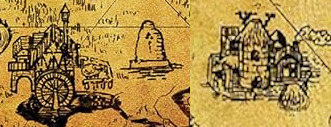
And that is everything I could find on this map. I seems to depict Ocarina of Time Hyrule, with its borders expanded with miscellaneous locations from other 3D Zelda games that were out in 2015. A lot of original locations are also mixed in. The origins of the map still remain a bit vague, but given how much it pops up in Zelda merch, it does appear to be official in some capacity. If anyone has more information about this topic, I'd be happy to know.
24 notes
·
View notes
Text
good work as always
On the origin of the Kingdom and the Alliance

Fire Emblem: Three Houses and Fire Emblem Warriors: Three Hopes are home to many story threads that are hidden under the surface and can only really be understood by taking a look at many disparate sources in these games. One such thing is a peculiar question that is asked by professor Manuela in Chapter 11 of Three Houses, which involve spoilers for both games under the cut.
During that chapter, the existence of the Holy Tomb is revealed under Garreg Mach Monastery. The Monastery is located in the Oghma Mountains in the center of the continent Fódlan, a fairly inhospitable area, and this leads Manuela to speculate that the Monastery was built in this location to be near the Holy Tomb.
However, she then goes on to make an interesting observation. Garreg Mach and the Oghma Mountains lie at the center of Fódlan's three nations: the Adrestian Empire, the Holy Kingdom of Faerghus and the Leicester Alliance. However, two of those nations were founded well after Garreg Mach was. Manuela questions why this is:
"I understand now why they'd build the monastery in the mountainous center of Fódlan. Although… When the monastery was built, the Kingdom and Alliance weren't even around yet. But look how cleverly it was placed right in the middle of the Empire, Kingdom, and Alliance. That's weird, right?"
It is interesting that the game itself calls this out in this way and there may be an actual answer to this question, but it does require looking at the origin of both Faerghus and Leicester in detail.
Setting the stage: Adrestia and Garreg Mach

To start with, before the founding of Faerghus and Leicester, Fódlan looked more or less like the image above politically speaking. The Adrestian Empire had been founded at the start of Fódlan's modern calendar in the south of the continent at the city of Enbarr by Seiros and Emperor Wilhelm I. They would go on to wage the War of Heroes with Nemesis and the Ten Elites, who lurked in the north of the continent according to a Scholar in Chapter 17 of Crimson Flower:
"Over a thousand years ago now, not long after the Adrestian Empire was founded… The first emperor and his army, with the aid of Seiros, set out on a campaign to the north with the aim of unifying Fódlan. Meanwhile, in the northern reaches of Fódlan, Nemesis, the King of Liberation, raised an army to take down the Empire…"
After 60 years, the war ended with victory for the Adrestian Empire and the unification of Fódlan under its banner. Nemesis and the Ten Elites were killed, while their descendants became the new nobility of the Empire.
The Church of Seiros had been founded by Seiros as well in the beginning days of the Empire and received multiple branches throughout Fódlan after the war: in the east, west, south and center. The Central Church came to be seated at Garreg Mach Monastery in the Oghma Mountains in the center of Fódlan. The monastery was completed in the Imperial Year 185, about a century after the War of Heroes ended.
Origins of the Kingdom: Eagle and Lion
Until the Imperial Year 747, the hegemony of Adrestia stood as Fódlan only had to wage war with foreign nations like Dagda and Brigid. However, this changed when Loog, a descendant of the Elite Blaiddyd from the north of Fódlan, rebelled against Adrestia. He demanded independence for the region of Faerghus, which started the War of the Eagle and the Lion. In this war, Loog was aided by two advisors: Kyphon, a descendant of the Elite Fraldarius, and Pan, a strategist of whom much has been lost to history and who is only really mentioned in Ferdinand's A Support with Byleth.
The war was a success for Loog, as he won it and afterwards, the Church of Seiros mediated between Faerghus and Adrestia. The Church supported Loog's right to rule Faerghus in exchange for the Seiros religion to become Faerghus's official religion and to publicly proselytize in the territory. As such, the Kingdom was called holy and retains close relations with the Church even during the present day, as said by a Knight of Seiros in Chapter 4 of Three Houses.

Origin of the Alliance: A Rebellion and Two Wars
50 years after the founding of Faerghus, the Leicester region in the east of Fódlan also rebelled against Adrestia. The Kingdom saw this as an opportunity to expand its influence and occupied the region, declaring Leicester a part of its territory.

This situation remained stable for another 60 years, until the death of king Klaus I in the Imperial Year 861, which led to the division of Faerghus into three for a while. The events of this are detailed in a novel called The Death of King Klaus in Three Hopes and given a few details in the Burnt Remnants of a Report from Three Houses's Shadow Library.
King Klaus had three sons named Banfig, Krouffer and Kite. Before his death, Klaus caught a deadly fever and was so delirious he could not decide which of his three sons would succeed him. One day, his sister Morianne found a note written by him that said that whoever is most beloved by the people shall have the throne. This note may have acted as the will mentioned in the Burnt Remnants of a Report, and so failed to name a successor and demanded the Kingdom be divided among the three princes: the Leicester region in the east, the Faerghus region in the middle and the Mach region in the west. The princes themselves also agreed to do this and a faction of knights sided with each.

War would break out between the three regions before long, with Prince Krouffer emerging victorious. He became the king of Faerghus while his brothers remained archdukes of their respective regions. In reality, the will had been forged by Morianne in a plot to put Kite on the throne, but this had failed in the end.
This situation did not remain stable for long as when Kite died, he did not leave a heir and the lords of the Leicester region with blood ties to House Blaiddyd refused to recognize the next archduke in line. Instead, they tried to form a republic and fought with Faerghus over this in the Crescent Moon War. After 20 years of fighting, they succeeded and the Leicester Alliance was founded. This is when the modern borders of Fódlan were established.

The darkness lurking behind history
So far, this seems all like fairly typical Fire Emblem fare as rebellions and wars that lead to the founding of nations are very common in the history of the various continents in the series. However, this does not explain why the nations all seem to be centered around Garreg Mach Monastery. The contents of the Shadow Library hint that there lurks more behind these events as well, particularly in the aforementioned Burnt Remnants of a Report.
The document is interesting as it gives insight into a few recent conspiracies that have gone down in Fódlan's history, in particular with regards to the Tragedy of Duscur that threw Faerghus into chaos and the assassination of the heir to the most important house of the Alliance. However, the Report also gives comments on the events further back into Fódlan's history.
On the events that sparked the founding of Leicester, it is mentioned that the death of King Klaus was likely an assassination and in the Japanese version that whoever the guilty party was, their goal was to weaken and divide Faerghus because it was growing stronger than Adrestia. It seems doubtful that Morianne was interested in this, given what little we hear of her only paints her as being interested in putting Kite on Faerghus's throne, so she might have been part of a larger scheme at play:
"…One day, Klaus's sister Morianne found a note supposedly written by her brother. [...] ..She despaired that her scheme had failed. Her plan to install her preferred Prince Kite as king was disrupted by one so banal as Krouffer."
As for the events that led to the founding of Faerghus, it is mentioned that Loog's army mysteriously obtained weapons that were similar to the Heroes' Relics and was able to gather soldiers without anyone noticing. Many fishy things are lurking behind the War of the Eagle and the Lion.
This makes sense, as the guilty party is mentioned explicitly in this part of the Report, which details the first tear in the unified banner of the Empire, and the common thread between all the conspiracies of this document:
"What is the true identity of Pan, the tactician rumored to have been integral to Loog’s victories? And Those Who Slither in the Dark…"
Agartha's Long Game

The Agarthans or Those Who Slither in the Dark were explicitly involved with the Tragedy of Duscur and the political turmoil in Adrestia in recent times, and were likely behind the assassination of the heir of House Riegan in Leicester as well. But their influence stretches back way farther into Fódlan's past, as the mysterious tactician Pan was one of their members and supplied Loog with weapons and soldiers. The weapons are noted to be similar to Heroes' relics, which is mentioned to be the case for Agarthan weapons in the Forging Bonds Hint of Potential in Fire Emblem Heroes by Claude:
"I fought those who slither in the dark in Fódlan. Their weapons were of a similar material to the Heroes’ Relics."

And so the answer to the initial question posed by Manuela comes into focus. The War of Heroes fought at the start of Fódlan's calendar was in many ways a proxy war between Agartha and their sworn enemies, the Nabateans, the children of the goddess Sothis. The Agarthans were responsible for orchestrating the genocide of the Nabateans in the Red Canyon Tragedy through Nemesis. They also aided Nemesis during the War of Heroes, as Seiros was actually a Nabatean who sought revenge against Nemesis for his role in the Red Canyon Tragedy. This is most clearly seen in the Paralogue Cycles of Nostalgia in Three Hopes, where the Agarthan Epimenides is directly controlled as the player character and fights against the forces of the Empire and even Seiros herself.
However, the War of Heroes ended badly for the Agarthans. Nemesis and his allies were killed, their descendants swore fealty to the Empire and the factions controlled by the Nabateans came to rule Fódlan. So, in response they could do nothing but lay in wait and play a Long Game. They influenced the course of Fódlan's history from the shadows starting about 400 years before the two games take place by creating rifts in the unified banner of the Empire, as a house divided against itself cannot stand.
First they helped Loog to win his independence from the Empire and split the power of Fódlan in twain. When Faerghus stood to become too powerful with the acquisition of the Leicester region, they likely once again entered the scene and ensured that the Alliance was created.
Fódlan now has three seats of political power, all conveniently centered around Garreg Mach Monastery. The Monastery is the seat of power of the Church of Seiros and the Nabatean, Seiros, who continues to rule it under the guise of various identities. The Agarthans have also tried to attack Garreg Mach Monastery directly with their javelins of light, which are actually orbital missiles, and always fail according to a Hermit in Abyss in Chapter 18 of Verdant Wind and Silver Snow:
"Those lights that came down on Merceus…I might have seen them before, here at Garreg Mach. They looked like they'd rain down right on top of us, but at the last moment, they veered off… I think they crashed into Ailell. It must have been the goddess's blessing that protected us."

The Hermit is correct, as according to Rhea, the modern-day identity of Seiros, in Chapter 20 of Verdant Wind, the Holy Tomb was built by Sothis to repel evil:
"The Holy Tomb is not only the location of the progenitor god's eternal slumber, but also a sacred vessel for a power that repels evil. Supposedly, the progenitor god built the Holy Tomb herself to protect her children from the evil light."
As the direct approach continues to fail, the Agarthans also have a secondary plan to attack Garreg Mach, which is the result of their meddling in history and the creation of the Kingdom and Alliance. Their modern day conspiracies are a continuation of this. As I wrote in my Enbarr Conspiracy post, the goal of their efforts in Adrestia was to create a peerless emperor to rule Fódlan. To this end they committed atrocities in Enbarr and Duscur, as said in Chapter 10 of Three Houses:
Flame Emperor/Edelgard: "There will be no salvation for you and your kind. Those responsible for such gruesome deeds in Duscur and Enbarr." Thales: "All so that you may acquire the strength you need. All for a purpose…"
The conspiracy in Enbarr was needed for Edelgard to obtain the blood of Sothis and gain the Crest of Flames, to increase her personal power. But it seems a bit unclear why the events in Duscur would be necessary, as Edelgard had only tangential involvement there. The strength Thales mentions here is likely political strength, as the fallout of the Tragedy of Duscur allows the Agarthans to put one of their own, Cleobulus, in charge of the Faerghus Dukedom in the non-Crimson Flower routes of Three Houses. The Dukedom becomes an ally of the Empire in the war in the second half of Three Houses.
This is likely what the Agarthan conspiracies are all about: securing the three seats of power around Fódlan so they could mount an attack against Garreg Mach from all sides. This is why they target the children of Emperor Ionius IX, the royal family of Faerghus and the heir of the leader of the Alliance, and seeking to either turn them into pawns for their own ends or to assume control of the nations directly. All to complete their revenge against the Nabateans that they started with the Red Canyon Tragedy, even if in the end they are only partially successful in these plans.
"They [the children of men] swore a fervent oath of revenge against the surface world, ruled by beasts, and against their tormentor, the False God" -Romance of the World's Perdition
18 notes
·
View notes
Text
The True Nature of the Ghost Ship: A Legend of Zelda Halloween Theory
This theory will be citing the gameplay changes and minor story retcons present in The Legend of Zelda: The Wind Waker HD
In The Legend of Zelda: The Wind Waker, one of the most iconic parts of the latter half of the game is the search for The Ghost Ship.

The Ghost Ship is a phantom ship that is present at night in certain quadrants of the Great Sea. The quadrant it appears in is dependent on the phase of the moon on that night - for example, on a full moon, the ship will be present at Crescent Moon Isle. It is translucent in appearance, with tattered sails and the spirits of the dead floating around it, and, without the Ghost Ship Chart, one can sail straight through it. When the Ghost Ship is present, a storm will start, and when getting close, an ominous chant can be heard.
それから、数百年・・・ あのガノンさえ、蘇らなければ このハイラルは永遠に 眠りから覚めることは、なかったのだ
Have you seen it? The Ghost Ship also appears in these seas… On the nights of the downward crescent moon...
Fishman (The Wind Waker) - Translated by Sidier
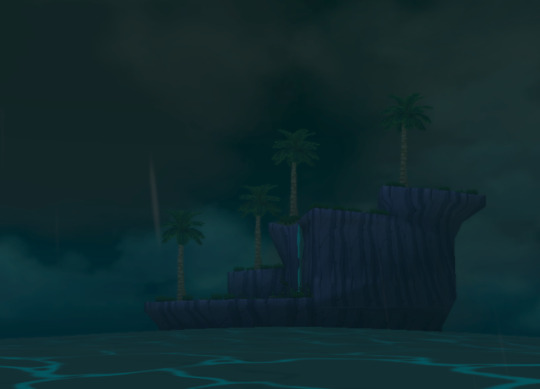
On Diamond Steppe Island, an island in the southwest of the Great Sea, there is a grotto that Link can enter. Upon delving inside, Link finds a ship graveyard - multiple ruined ships, filled with Floormasters.
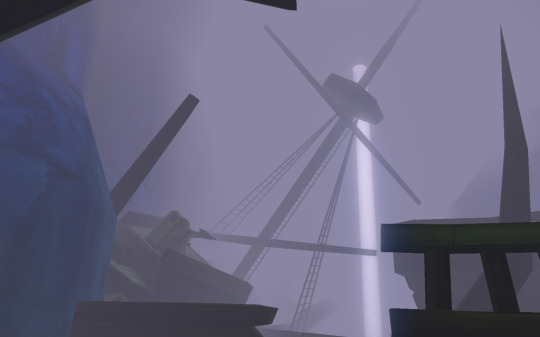
Upon exploring this ship graveyard, Link finds the Ghost Ship Chart, which shows Link the location of the Ghost Ship is each night, and, upon encountering the Ghost Ship, he can now sail into it to actually board it.
We learn about the Ghost Ship Chart at an earlier point in the game, when Link encounters Lenzo. Lenzo informs Link that the Ghost Ship Chart was made by a man who sought the treasure of the Ghost Ship and wanted to document its movements. However, upon completion of the chart, the man suddenly died.
ある時、船が壊れてしもうてな わしは潮に流されるまま、海を 漂っておった・・・そんな時じゃ 海の彼方に見たのじゃ 幻のように透き通る不吉な船 そう・・・幽霊船の姿をな うわさでは幽霊船が出没する海域を 調べた男がいて、それをマップに 記したそうなのじゃが・・・ 書き上げてまもなく男は 亡くなったらしい ・・・おそろしや~ まあ、そのマップさえ手に入れば 幽霊船にのりこんで、中の財宝を そっくり頂けるかもしれんがの!
One day, my ship broke and I drifted along the seas, driven by the currents… That was when I saw something far away… A transparent, creepy ship, almost like an illusion… Yes… I saw the Ghost Ship… Rumors say that a man investigated the areas where it appears and wrote up a map, but… He died shortly after completing it… How scary! Well. If you can get a hold of it, you can board it and might able to take the treasures!
Lenzo (The Wind Waker) - Translated by Sidier
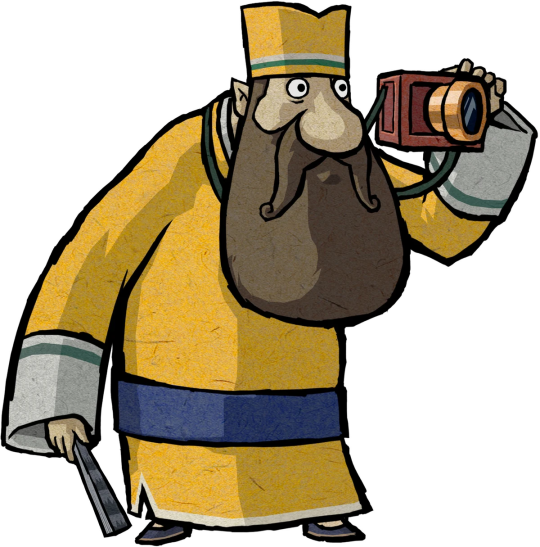
When Link enters the ship, he is transported into what appears to be another dimension. The ship appears very similar to one of the many other Submarines in the game or the bottom level of Tetra’s ship, but many parts of it are torn off, and through the gaps are inky black darkness, with the spirits of the vessel seen floating on the bottom floor of the ship.
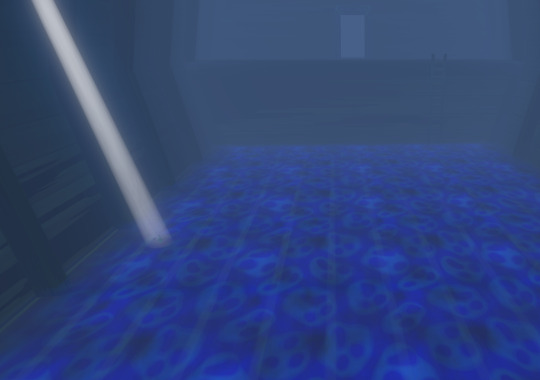
After defeating the ghostly enemies present, a ladder drops down, which Link can then use to climb up and acquire the Triforce Shard concealed within the ship. An ear-piercing shriek rings out, and Link wakes up on the King of Red Lions, back on the Great Sea, now suddenly morning.
While this is a fun and interesting questline, the ship actually doesn’t give us much to go on in terms of lore or story. However, this Halloween, I would like to propose a theory based on the limited evidence we have, and determine what exactly the Ghost Ship is and why it protects a Triforce Shard.
To preface the theory itself, it is necessary to establish a running trend with the Triforce Shard locations that are found on the islands of the Great Sea.
The King of Red Lions establishes that when the Hero of Time crossed the boundaries of time and returned to his childhood at the end of Ocarina of Time, the Triforce of Courage from the Adult Timeline was split into 8 pieces and hidden throughout the Great Sea.
時の勇者が時を旅してハイラルを去る時 勇者のもとを離れ、8つのかけらとなって各地に飛び散ったと言われている
It is said that when the Hero of Time left Hyrule on his journey through time, the Triforce of Courage left him and was scattered among the land in the form of eight pieces.
The King of Red Lions (The Wind Waker) - Translated by Jumbie
While it is never specified in-game if the Triforce Shards were hidden before or after the flood, facts in-game make it likelier that it occurred after the flood. For example, the fact that the majority of the Triforce Shards are found on the surface of the sea rather than needing to be pulled up via the Grappling Hook suggests they were hidden at a time when the islands were the only accessible land. In corroboration of this, the presence of Triforce Sea Charts that reveal the locations of the Triforce shards suggests that their locations were only concealed after Hyrule was already flooded and the world was divided up into maritime quadrants.
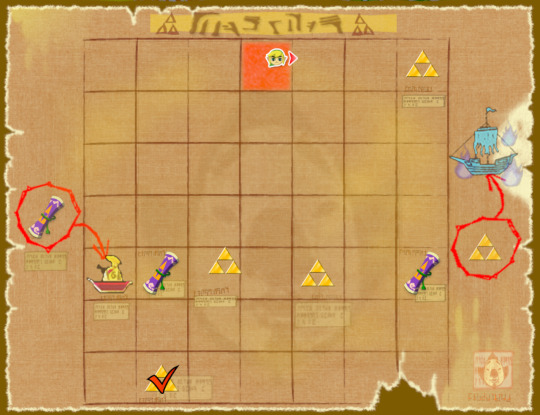
Because of these facts, it is very likely the Triforce Shards were hidden in a time when the flood had already occurred and Hyrule had been swallowed by the Great Sea.
Many of the hidden Triforce Charts and Shards are directly hidden behind locations that are tied to the Royal Family. For example, many of the Triforce Shards are hidden within caves that utilize the same type of architecture present in the Tower of the Gods and Hyrule Castle. Furthermore, they are also hidden behind the usage of the Wind Waker, a relic of the Royal Family. While Daphnes may have been in possession of the Wind Waker during the time between the flood and The Wind Waker, this does not preclude the descendants of Daphnes creating seals on the Triforce Shards that would require the Wind Waker to unseal them.

Given this shared architecture, as well as the importance placed on the Wind Waker, it becomes immediately clear that the hiding of the Triforce was done at the behest of the Royal Family, or what remained of it, following the flood. You might wonder, however, what this has to do with the Ghost Ship.
Taking into account the totality of these factors, it’s likely the Ghost Ship was specifically made by the surviving Royal Family and its servants as a means of protecting a Triforce Shard, similar to how they hid the other Triforce Shards in locations across the Great Sea. However, it’s unlikely that the surviving Royal Family members and their servants created the actual Ghost Ship, given its supernatural origins, so it’s likelier they created the thing that became the Ghost Ship.
Returning to Diamond Steppe Island for a moment, I mentioned that there is a ship graveyard there, and it is in that graveyard that Link discovers the Ghost Ship Chart. However, there is something peculiar about one of the ships present in the graveyard; upon closer analysis (and a bit of clipping through a wall), it can be determined that this ship is just a broken down version of Tetra’s Pirate Ship, as it is identical in almost every way, including the figurehead!
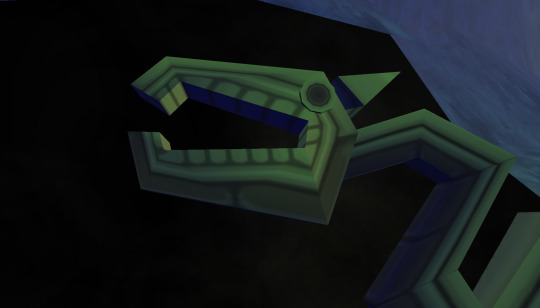
A nigh identical ship graveyard can also be found one quadrant north, at Needle Rock Island, with the same ruined ship.
However, what does that tell us about the Ghost Ship? Interestingly, the Ghost Ship is also nearly identical to Tetra’s Pirate Ship. However, there’s a noticeable difference; the figurehead is not that of the one found normally on Tetra’s ship, but of a strange figure, with what appears to be its hands clasped in prayer.
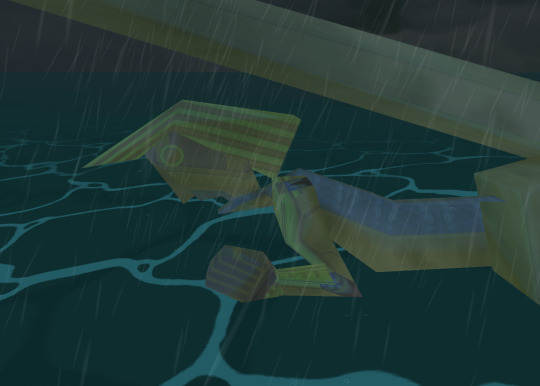
Despite this difference, it can be demonstrated that the Ghost Ship shares the model of the ship used by Tetra and her crew, a vessel of the Royal Family, implying that the boats are of the same make, similar to the destroyed boats in Diamond Steppe Isle and Needle Rock Isle.
Strangely, the figurehead of the Ghost Ship has a very strong resemblance to the figures that are depicted in the introduction tapestry of The Wind Waker who were praying to the Gods after the Hero of Time’s failure to appear.

What could this mean? Suppose for a moment these praying figures in the tapestry were servants of the Royal Family, and survivors of the flood - very likely, considering the Royal Family were the ones who had the tapestry created following the flood, given its presence in Tetra’s room on her ship.
As we know from Diamond Steppe Island, multiple of the same model of Tetra’s Pirate Ship were made, and it’s likely that it was simply the ship style that was utilized by those directly affiliated with the Royal Family. Given the presence of the Triforce Shard on the Ghost Ship, it’s likely that, in life, it was a regular ship that consisted of a crew that protected the Triforce at the behest of the Royal Family. However, as we’re told in The Wind Waker, centuries have passed since the original flooding event.
それから、数百年・・・ あのガノンさえ、蘇らなければ このハイラルは永遠に眠りから覚めることは、なかったのだ
Centuries have passed since then... If Ganon had not revived, Hyrule wouldn't have awakened from its endless slumber.
Daphnes Nohansen Hyrule (The Wind Waker) - Translated by Sidier
Like all mortal men, the crew of this ship dedicated to the protection of a Triforce Shard were doomed to die, whether it be through old age or some other unforeseeable disaster at sea. However, given the presence of the Ghost Ship in the modern day, still protecting the Triforce Shard, is it likely that those deceased souls - the ones who survived the flood, and who protected the Triforce Shard - then went on to continue roaming the Great Sea in the form of an undead crew on their supernatural ship. This would be reinforced by the fact we see a ruined Royal Family ship in Diamond Steppe Isle, which, coincidentally, is also the same location we find the Ghost Ship Chart. We know that the Ghost Ship Chart was made by a man seeking the Ghost Ship’s treasure; is it possible the Ghost Ship killed this man somehow, as a way of protecting the Triforce, and hid the chart in Diamond Steppe Island? If this is the case, it’s likely that it is capable of moving other objects, and is likely the reason the ship graveyard exists in Diamond Steppe Island in the first place.
From there, it is also possible, then, that the ruined Royal Family ship we see in Diamond Steppe Island is actually the “corpse” of the Ghost Ship, and the phantom ship we see roaming the seas is the spirit of this ship transformed, with its figurehead now resembling the praying figures who survived the flood - the servants of the Royal Family, who now, in death, continue protecting the Triforce Shard. However, it’s also possible that the Ghost Ship’s original ship was just an unseen fourth ship separate from Tetra’s, the Needle Rock Isle ship, and the Diamond Steppe Isle ship.
Regardless, this interpretation also explains why the ship disappears once Link acquires the Triforce Shard; the purpose of the ship and its crew was to protect the Triforce Shard, which they would continue doing even after shedding their mortal coils. But now, with the appearance of the one true Hero and his acquisition of the Triforce Shard, they can now leave the Great Sea and move onto the afterlife, their ultimate purpose finally fulfilled.
In summary, the Ghost Ship was a ship that consisted of servants of the Royal Family who survived the flood. The surviving Royal Family hid the Triforce Shards throughout the Great Sea, and one of shard was hidden amongst a group of these servants who had their own ship. However, eventually, the ship was destroyed somehow, and its ruins either sunk to the seafloor or possibly even found their way to the Diamond Steppe Island ship graveyard, either via natural or supernatural means. The Ghost Ship, the twisted and warped spirit of this ship, continued sailing the Great Sea, with its undead crew still protecting the Triforce Shard. A man seeking to acquire this treasure created the Ghost Ship Chart, and dropped dead upon completing it. The chart was then placed in Diamond Steppe Island, somehow, likely related to the Ghost Ship’s supernatural abilities. Eventually, the Hero of Winds stumbles upon the ship graveyard as well as the Ghost Ship Chart, and upon entering the Ghost Ship, he puts its undead crew to rest and acquires the Triforce Shard, allowing the Ghost Ship to end its reign as terror of the seas.
However, there is still much about this ship that goes unexplained. Why was its chart on Diamond Steppe Island? Why does it favor certain islands on the Great Sea based on the phases of the moon? While an answer to questions like these would explain practically everything surrounding the Ghost Ship, perhaps it’s for the best that this phantasmic ship still has some mysteries left unanswered...
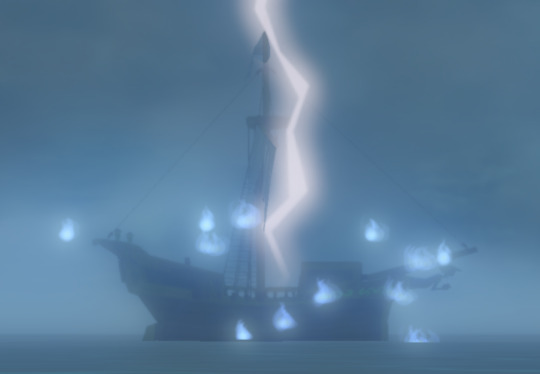
#zelda#zelda lore#the legend of zelda#tloz#legend of zelda#zelda theory#zelda history#the wind waker#zelda the wind waker#tww#nintendo#nintendo lore#nintendo theory#ghost ship#zelda halloween#nintendo halloween#halloween
33 notes
·
View notes
Text
Made a graphic explaining how I think the backstory of A Link Between Worlds ties in with the wider series, specifically lore from A Link to the Past, Ocarina of Time, Twilight Princess and Skyward Sword a few days ago and thought it would be fitting for this blog (zoom in to read the text).

10 notes
·
View notes
Text
It’s possible that Dinosaur Land is located in the Cascade Kingdom from Super Mario Odyssey. Both areas are characterised by being one of the only locations where living dinosaurs are still found and their coasts having sheer drops and cliffs, with land high above sea level.

Source(s):
Super Mario Odyssey - Co-Op Demonstration - Nintendo E3 2017
Super Mario Odyssey, Nintendo Co., Ltd. website
Super Mario Odyssey, Nintendo Co., Ltd. website
49 notes
·
View notes
Text

Taking a brief respite from content related to The Legend of Zelda, this is a chart I created outlining exactly how wishes are fulfilled in the Mario universe, based on information from Super Mario RPG, Paper Mario, and Mario Party 5. As noted in the bottom right corner, special thanks to @seandwalsh and @ym-loreposting.
#mario#mario lore#super mario#super mario lore#super mario rpg#smrpg#paper mario#paper mario 64#mario party#mario party 5#nintendo#nintendo lore
179 notes
·
View notes